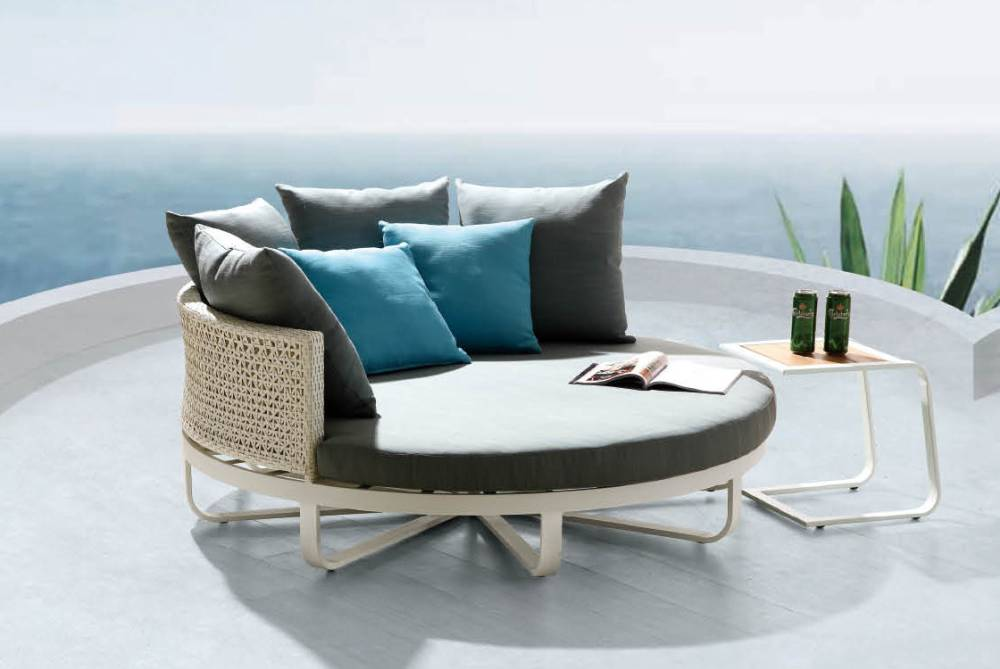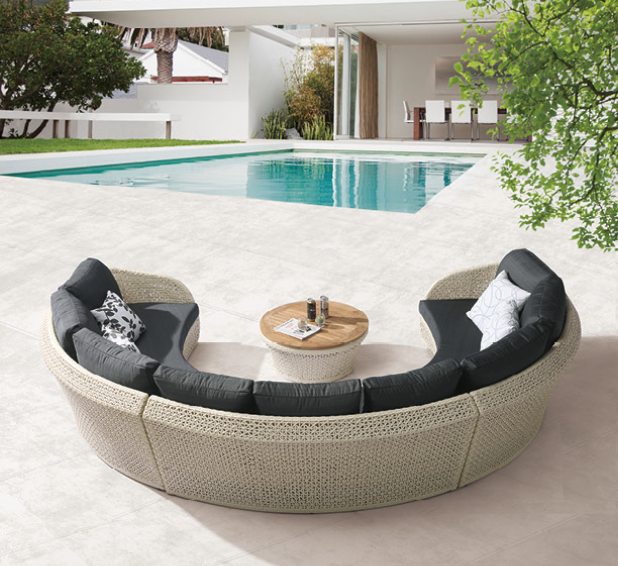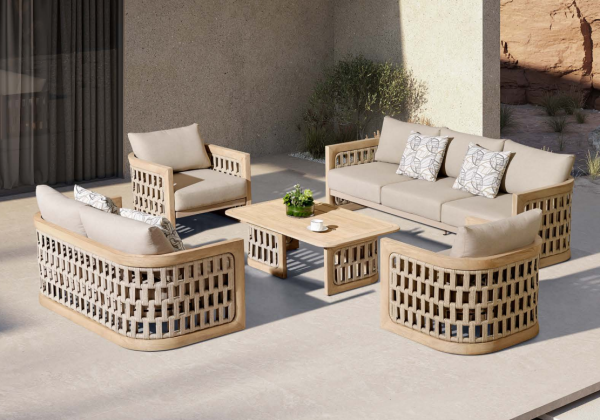Wicker vs Rattan: Which is Best for Patio Furniture - Babmar

When discussing something like outdoor accent chairs, the terms “wicker” and “rattan” are often used interchangeably. But there are distinct differences. For instance, rattan is a plant material that’s used in wicker furniture; “wicker” typically refers to a weaving process. When used in terms of outdoor furniture, wicker furniture usually refers to a synthetic resin that’s woven to make items like outdoor chaise lounges or outdoor loveseats.
The natural material rattan can also be turned into furniture through this weaving technique for use both indoors and outdoors.
However, when exposed to the elements, synthetic wicker furniture tends to outlast rattan.
What is Wicker?
Wicker is both a weaving process and the name of the finished material itself. The typical “over-under” woven pattern results in a solid, very sturdy piece. The wicker weaving method is recognized as the oldest method of furniture making, going back as far as 3000 B.C. It had a style resurgence in the Victorian era for indoor pieces and has a place in modern design, as well.
Wicker furniture can be made from the cane of pliable natural plant materials like rattan, bamboo, willow, or seagrass. It can also be made from synthetics like vinyl that resemble these natural fibers but which prove to be more durable over time.
Wicker is a popular choice for pieces from an outdoor furniture store like Babmar because it’s stylish, sturdy, lightweight, and holds up beautifully against punishing weather conditions like sunlight and rain.
What is Rattan?
Rattan is a form of palm fiber. The strong yet flexible stems are ideal for weaving into things like baskets, mats, caned chairs, or other kinds of indoor furniture. There are a few forms of rattan, most of which can be turned into indoor or outdoor furniture; if cared for properly, it can last anywhere from five to ten years. However, most rattan isn’t waterproof and should be stored inside in cold or wet weather.
However, there are synthetic fibers that mimic the natural look of rattan but are far more durable against the elements. Unlike natural plant material, synthetic rattan holds up against rain and sun when used in wicker furniture.
Difference Between Wicker and Rattan Patio Furniture

The flexible nature of rattan fibers is ideal for weaving into various wicker patterns, like chairs, baskets, making furniture, and the like. The natural strength of rattan works well with this ancient weaving technique. However, it's not fully weather-resistant. Rattan requires certain care to last and look its best over time; its waterproof ability isn’t great, so rattan furniture should be put away or covered in wet weather. It can also fade from the sun. Rattan outdoor furniture needs the right kind of care to reach its full lifespan (about a decade), such as proper covers during inclement weather.
However, there are synthetic fibers and vinyl materials that resemble rattan and can be made into beautiful woven furniture that lasts. Synthetic wicker pieces are as strong as natural wicker materials, but they better resist rain, sun, humidity, and other punishing conditions. Plus, they’re lightweight and easy to move around. Synthetic rattan requires far less maintenance and care than its natural counterparts.
Flexibility and Comfort
The wicker weaving technique has been around since 3000 B.C. That’s because the “over/under” pattern creates a very strong and durable result. For outdoor furniture, wicker – whether it be rattan, willow, or woven from synthetic materials – will be flexible and comfortable. However, furniture made from synthetic materials will outperform rattan over time.
Weight and Portability
Both wicker and rattan patio furniture are pretty lightweight and easy to move around. Synthetic wicker pieces have a slight edge in the weight department, being a little bit lighter than natural rattan.
Material
Once again, the term “wicker” refers to a weaving technique whereas “rattan” is a plant material. Rattan, bamboo, willow, and similar plant fibers can be woven into cane webbing, a wicker-style piece or synthetic or vinyl versions can be used. Synthetic wicker is usually less expensive than natural fibers.
Durability
With proper care, rattan can hold up for years. But when used in outdoor pieces, weather conditions can take a toll on its lifespan. Over time, sunlight, humidity, and rain can weaken and fade these fibers leading to holes and tears. Covering or storing rattan patio pieces is recommended. Expect natural rattan to last anywhere between five and fifteen years, depending on the care and maintenance it gets.
Synthetic wicker, on the other hand, is built to withstand various outdoor elements. Outdoor wicker furniture will retain its good looks and performance for years. The average lifespan is between ten and twenty years.
Texture
The look and smooth texture of rattan are more consistent. Wicker that uses other plant materials (such as bamboo or seagrass) may be more varied in both feel and looks. Synthetic wicker, on the other hand, is more uniform overall.
Maintenance and Care
Wicker made from natural materials like rattan are beautiful, but they require special care to maintain those good looks over the years. Rattan can be weakened by rain and humidity and tends to fade in the sun; these pieces should be covered or stored during wet or cold weather. That's one reason rattan is best used for indoor pieces.
Rattan furniture, or natural wicker furniture, should be dusted regularly and cleaned with mild soap and water a few times a year. A protectant specifically designed for rattan should be applied once or twice a year to hold off the effects of UV rays and moisture.
Synthetic all-weather wicker, on the other hand, can endure punishing outdoor conditions for years. It should be regularly vacuumed to prevent dirt buildup and occasionally hosed down. Each season, do a deep cleaning with an all-purpose cleaner, then apply a weather protectant twice a year.
Price and Availability
As a natural material typically harvested from southeast Asia, rattan will be more expensive than the synthetic materials used in patio furniture. The availability of natural wicker can be impacted by various environmental factors. There may also be times when finding natural wicker furniture is more difficult because it must be sourced through specialized importers.
Synthetic wicker, on the other hand, is mass-produced from resin and more affordable. No matter what style you’re looking for for your furniture, it’s much easier to find. Shop Babmar’s outdoor furniture store for a wide selection!
Conclusion

When it comes to furniture like outdoor loveseats or outdoor accent chairs, the wicker look is always in! Wicker is a form of weaving that’s been around for centuries, dating back to ancient Egypt and is popular because of its strength and elegant appearance. That's why it will always be part of home decor trends.
Rattan is a natural plant fiber often used in weaving natural wicker pieces like cane webbing, mats, and baskets. It’s sustainable and durable. However, it may not always be optimal for an outdoor space: rattan tends to fade in the sun and doesn’t always hold up well against humidity and rain. Rattan pieces should be covered and stored in wet or cold weather.
Wicker patio furniture can be made from a woven material like synthetics or resin that closely matches rattan but proves far more durable over time. Synthetic wicker is easy to care for and water-resistant, standing up against UV rays and other weather conditions. It’s lightweight and can be moved around very easily. It also has the advantage of being more affordable than natural rattan pieces.
If you’re in the market for beautiful, durable, affordable patio furniture, such as an outdoor sofa set, look at what Babmar’s outdoor furniture store has to offer!
